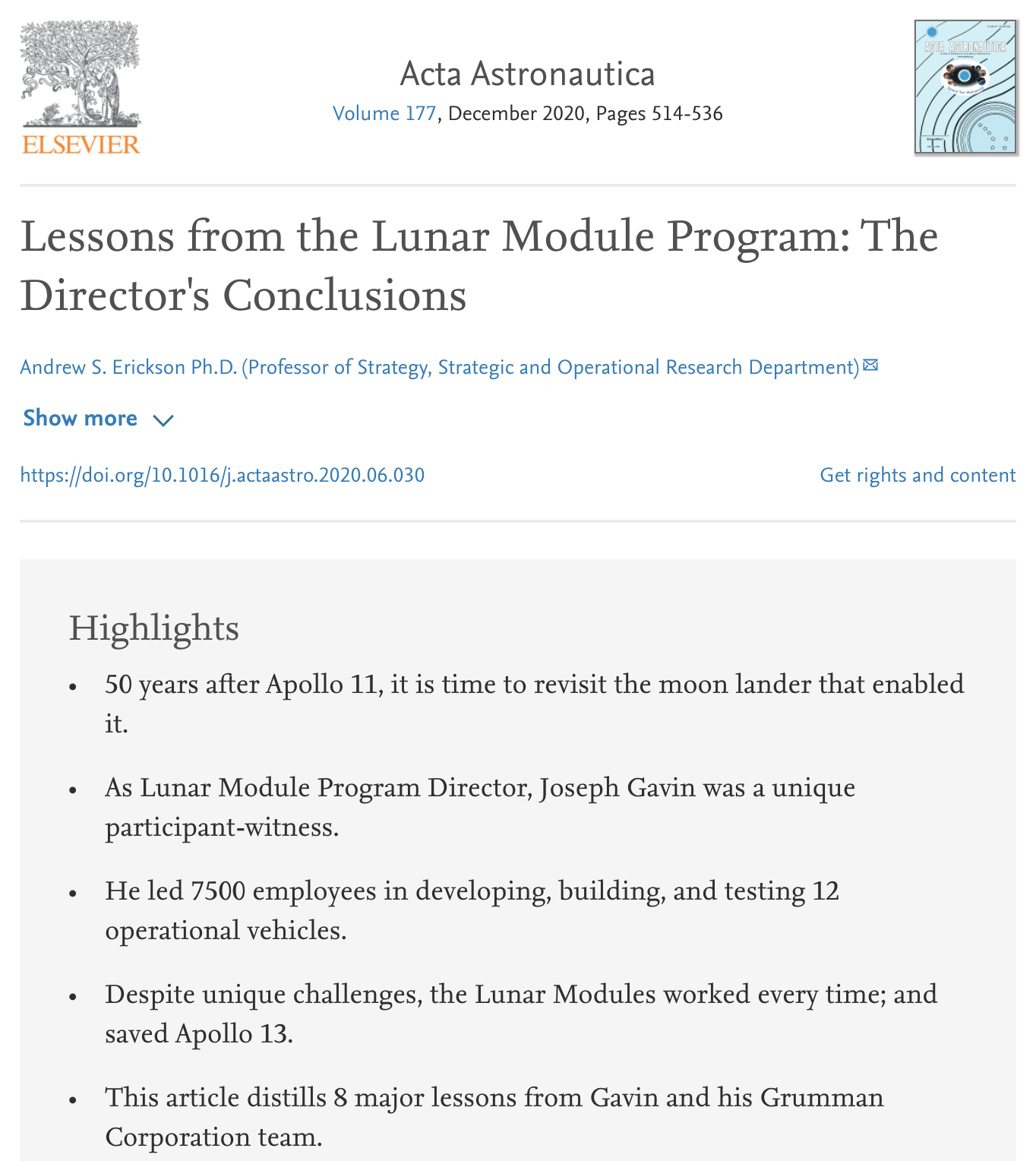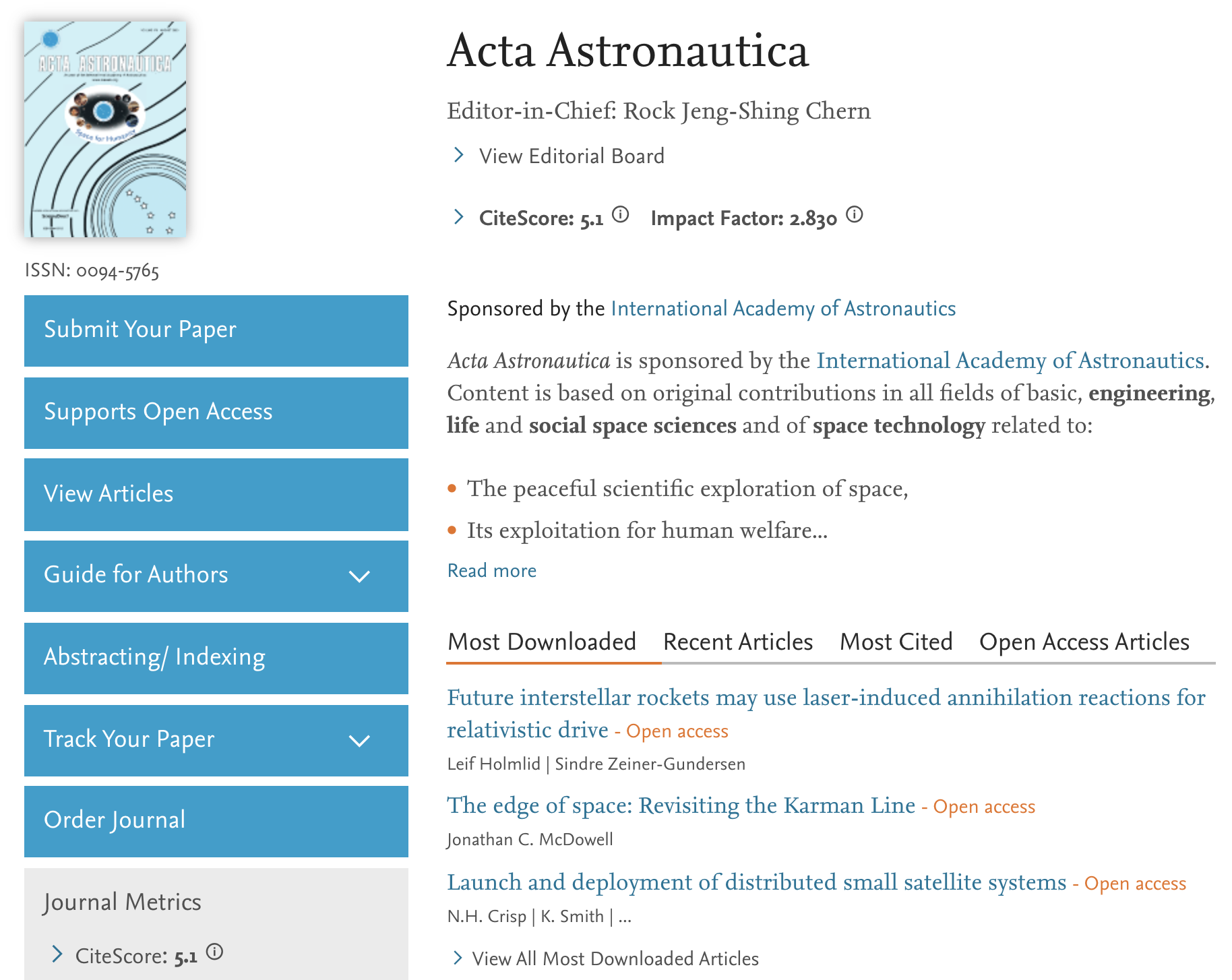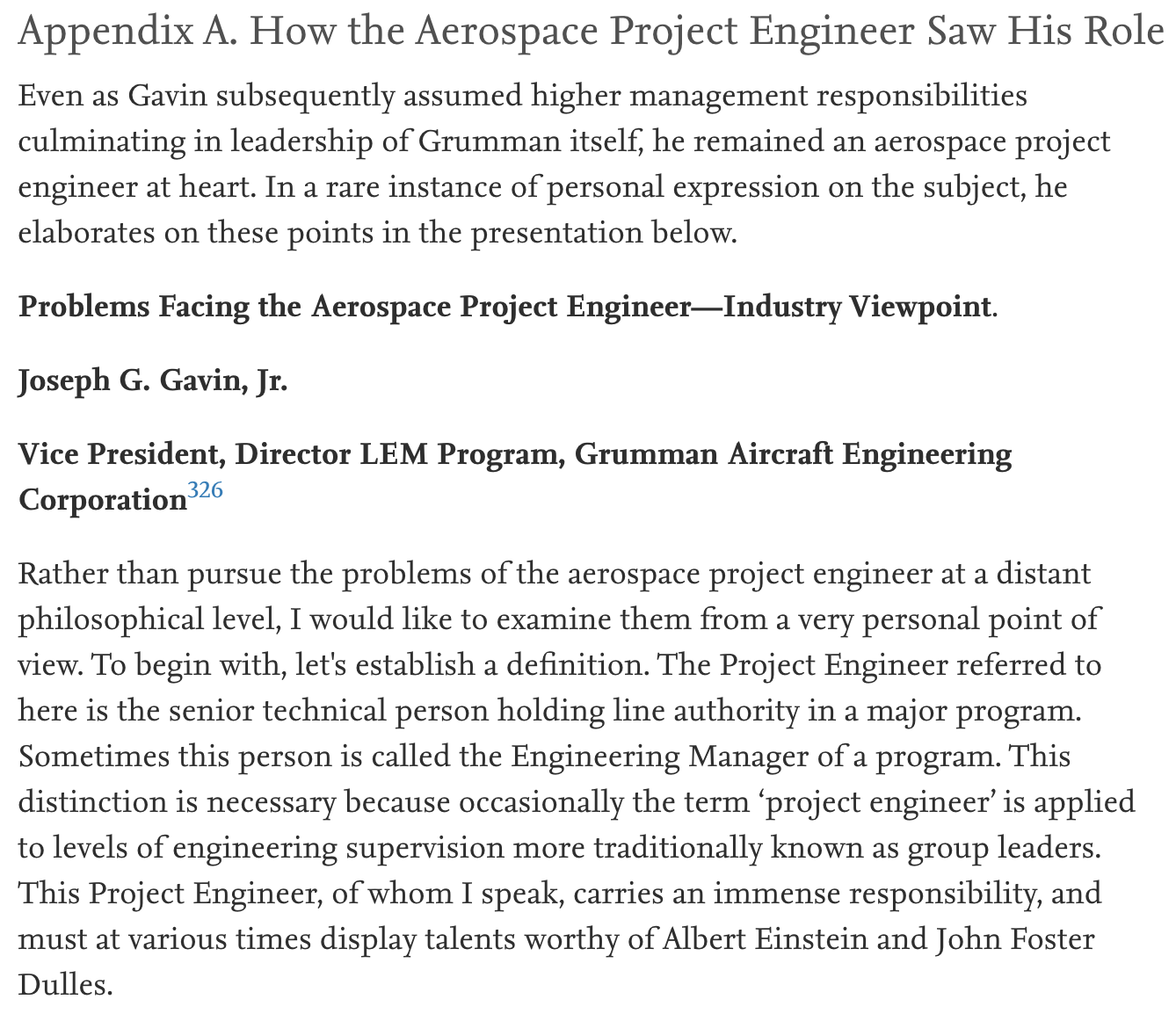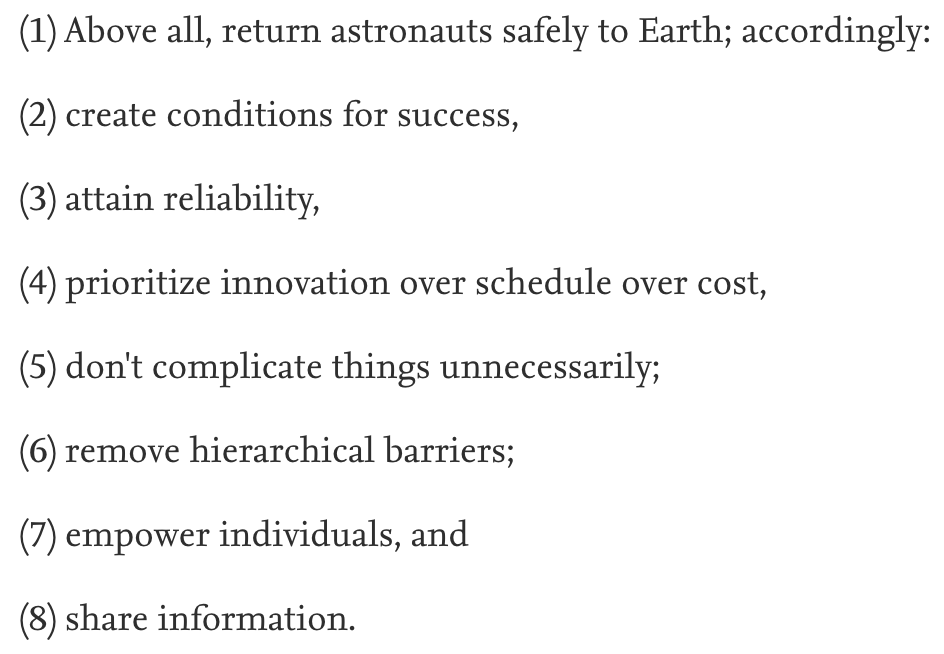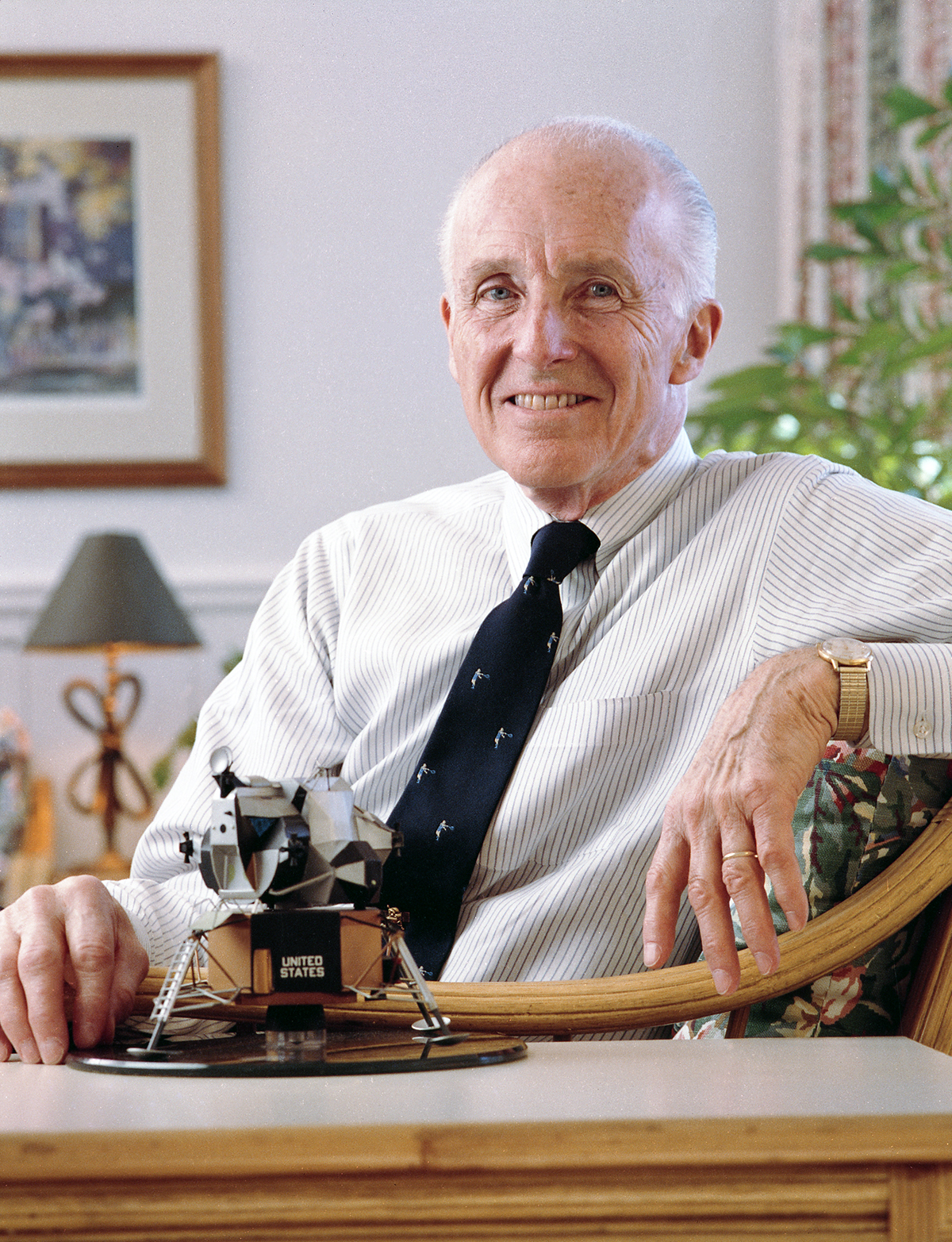Lessons from the Lunar Module Program: The Director’s Conclusions
Andrew S. Erickson, Ph.D. (Professor of Strategy, Strategic and Operational Research Department), “Lessons from the Lunar Module Program: The Director’s Conclusions,” Acta Astronautica, Volume 177 (December 2020): 514–36.
Naval War College, Newport, RI, 02840, United States
Received 1 February 2020, Revised 7 May 2020, Accepted 18 June 2020, Available online 26 June 2020.
Highlights
- 50 years after Apollo 11, it is time to revisit the moon lander that enabled it.
- As Lunar Module Program Director, Joseph Gavin was a unique participant-witness.
- He led 7500 employees in developing, building, and testing 12 operational vehicles.
- Despite unique challenges, the Lunar Modules worked every time; and saved Apollo 13.
- This article distills 8 major lessons from Gavin and his Grumman Corporation team.
Abstract
Half a century after the first piloted lunar landing, it is time to consider the program, lessons, and legacy of the lander that made it possible. This article does so from the perspective of Joseph Gavin, Jr., who led Apollo’s Lunar Module (LM) Program from its unofficial origins as a controversial dream at Grumman in 1960, to its official inception by NASA in 1962, to its successful conclusion in 1972. He directed as many as 7500 employees in developing the LM and ultimately building twelve operational vehicles. All met mission requirements, and those that actually made a lunar landing worked every time. Developing the state-of-the-art machine required unprecedented innovations and maximization of reliability amid inherently unknown and untestable conditions. When congratulated on the success of each landing, Gavin typically replied that he would not be satisfied until his spacecraft and its crew got off the moon and arrived home safely. This process required three procedures in unison (firing of explosive bolts, severing by guillotine of wires and other connections between the descent and ascent stages, and firing of the ascent engine). Each function could be tested on Earth individually, but not under lunar conditions at systems level. Gavin drew lessons from his Grumman Corporation team and its subcontractors’ experience that the author distills into eight principles:
(1) Above all, return astronauts safely to Earth; accordingly:
(2) create conditions for success,
(3) attain reliability,
(4) prioritize innovation over schedule over cost,
(5) don’t complicate things unnecessarily;
(6) remove hierarchical barriers;
(7) empower individuals, and
(8) share information.
Serving in top management subsequently returned Gavin to the naval aircraft development that remained Grumman’s specialty. He applied the best practices learned from LM development, particularly improving initial construction to reduce the need for tests (per principle three). Drawing on extensive interviews with Gavin and thorough examination of his personal materials, this article explores his lessons and explains how he envisioned and applied them in practice as an aerospace project engineer leading one of history’s greatest engineering achievements.
Keywords
Joseph G. Gavin, Jr., John F. Kennedy, Richard M. Nixon, Neil Armstrong, Buzz Aldrin, Apollo, Lunar Module, LM, moon, moon landing, Grumman Corporation, space, aerospace, aviation
Outline
- Highlights
- Abstract
- Keywords
- Lunar Module program, 1962-72
- Moonshot management: Lessons from Bethpage and beyond
- Lunar landing legacy
- Declaration of Interest Statement
- Appendix A. How the Aerospace Project Engineer Saw His Role
1. Lunar Module program, 1962-72
Having launched his career at the inception of jet engines and carrier aircraft as a Navy reservist in the Bureau of Aeronautics (1942–46), Gavin took it to a whole new level in the space age. Gavin’s aerospace project engineering leadership tracked Grumman’s preparation to bid for the eventual LM contract. Before Gavin assumed management responsibilities, however, he absorbed his profession’s fundamentals as a structural designer. On August 31, 1978, Richard J. Cyphers—then in charge of all Grumman’s structural designers—sent Gavin a set of the company’s detailed guidelines with the following annotation: “I am including a copy of ‘Structural Design at Grumman.’ This was done in 1965 and to this day every job applicant … if he accepts the job, on his starting day … gets this memo. All of the existing designers also receive it, so you can see that your own penchant for meticulousness has impacted more than a thousand designers since 1965.”1 While to the author’s knowledge Gavin did not draft the memo himself, he was clearly credited with coming to embody and inculcate its ethos throughout the corporation he came to lead.
Following a decade of naval aircraft project management, as Grumman’s Chief Missile and Space Engineer from 1957 to 1962, Gavin planned and directed all spacecraft and missile technical activity for Grumman and led the corporation’s unsuccessful 1958 bid on Project Mercury. Heading a new organizational entity as Space Programs Director further consolidated his leadership of Grumman projects in an exciting new domain. This included Grumman’s first NASA contribution: building the launch adapter and canister for Echo 1, the agency’s first communications satellite.2 Still more significant, and with more foundational implications for Gavin and his team, was their second NASA contract in 1960 to build the agency’s first space telescope, the Orbiting Astronomical Observatory (OAO). Innovations necessitated by the OAO’s unique challenges, Gavin explains, “later formed the basis for our heat disposal system on the LM.”3
With the Soviet launch of the first artificial satellite on October 4, 1957, Gavin “was a little surprised that they got there first.” On November 3, in his dayplanner, he noted: “2nd Soviet satellite.” But he had anticipated possibilities for spaceflight: “At the end of my tour in the Navy, we wrote a report at the request of Senator [Harry] Truman about where the Navy should go in the future. We suggested that the Navy should be interested in navigating outside of the atmosphere. So the idea took hold of doing something [in space]. It was not a new idea.” Soviet success “stimulated a lot of interest, [which] extended nationwide.” NASA funded studies on reentry bodies; Grumman conducted its own: “orbital navigation was related mathematically to some of the work we had done on [the optimum flight path] of jet airplanes.”4 … … …
3.2. Profession, inspiration, contributions
This concluding section reflects on Gavin’s core identity, motivation, and legacy as an aerospace project engineer. Gavin enjoyed an extraordinary engineering-executive career in an extraordinary age for American achievements in air and space. His employment coincided exactly with the Cold War era’s lofty defense spending and ambitious megaprojects. Like an unusually talented and fortunate surfer, Gavin caught an unprecedented wave at just the right time and rode it nearly perfectly. Yet this would not be indicative of conditions before or since in what President Kennedy termed the “new ocean” of space.307
Gavin’s wide-ranging responsibilities, contacts, and experiences afforded him unusual insights into the military-technological frontier of his era and the people that propelled it. Along the way, Gavin enjoyed fascinating personal experiences.308 He met President Johnson at the White House, attended the “Dinner of the Century” President Nixon hosted honoring the Apollo 11 astronauts, briefed Senators and Congressmen, and knew successive Secretaries of the Navy.309 Among his favorites: “I met Orville Wright before he died … showed Charles Lindbergh the Lunar Module under construction310 [and] survived the anxious hours of Apollo 13.”311 Clearly inspired by history’s first successful heavier-than-air powered aircraft, Gavin kept artist’s drawings of the Wright Flyer, as well as a copy of its original patent, in his personal collection. He also briefed von Braun on Grumman’s original Apollo bid,312 escorted him on his visits to Grumman and hosted his inspections of the LM,313 and spoke with him on many other occasions.314
Gavin’s own combination of diligence, personal modesty, and constant focus forward rather than on recounting the glories of past accomplishments is reflected in a glowing memorial tribute by Armstrong. He described Gavin as “a highly regarded aerospace engineer” as well as “an engineer and engineering manager in the highest tradition of the National Academy of Engineering [who] will be well remembered.”315 It reads as the heartfelt admiration and respect of one humble engineer’s engineer for another.
Asked for career guidance, Gavin advised, “Find a way to do something you love. You’ll never do anything better.”316 He emphasized, “The most important thing to be doing [is] the thing that you would rather be doing … I happened to get hung up on flying machines.”317 “When I was at Grumman I was doing something I would have preferred to do over anything else,” he illustrated. “When you’re in that situation, the hours don’t mean much. You do whatever is necessary.”318 Explaining the tremendous commitment and sacrifices that Grummanites made for the LM, Gavin emphasized, “There wasn’t any question in anybody’s mind that we were going to make it work, that we were not going to leave any astronauts on the moon, and that we were going to get them back safely.”319
Most fundamentally, the excitement of innovation in engineering inspired and drove Gavin: “There’s a certain exuberance that comes from being out on the edge of technology, where things are not certain, where there is some risk, and where you make something work.” He was forced to elaborate on this core philosophy when, during one of his many classroom talks, a schoolgirl asked him, “Mr. Gavin, why would anybody want a job like the one you had?” He replied: “Well, you must understand that there’s a certain satisfaction in living and working at the cutting edge of new technology. And while this isn’t for everybody, for those of us who are true enthusiasts, it is the place to be.”320 As for the LM specifically, “This wasn’t just another flying machine, this was unusual. It had not been done before. And I think there’s something that many engineers respond to in the sense that it is at the forefront of knowledge and there are risks being taken.”321 Regarding the space program writ large, “In the decade of the sixties, there was no question that there was a sense of competition with the Soviets, and that the Apollo Program was considered a regaining of our leadership in technology. It had impacts in the educational system, it inspired a whole generation of young people to be interested in high technology.”322
Asked to define his profession, Gavin opined, “I think aerospace engineering is a little bit different. The margins are less, and you’re defying gravity every day. The results, if you fail, are quite notable. If you look at the margins of safety in a bridge or an airplane, it’s really a different game. Being an aeronautical engineer myself, [I can attest that] we live more dangerously. And so we’re more careful.”323
Gavin’s lifetime of devotion to the pursuit of technological innovation at the frontier of cosmic discovery is encapsulated by the quote by George Bernard Shaw that was flown to the moon on his behalf: “You see things, and you say: ‘Why?’ But I dream things that never were, and I say ‘Why not?’”324
Gavin did far more than dream, however. By nature and interest, he was also a leader and a doer. Management, innovation, and execution defined his life’s work. Indeed, no matter how far he rose in status and accomplishment, he remained an aerospace project engineer at heart. It was in that role, most prominently in the climactic Apollo decade, that Gavin made the contributions for which history will most remember him. It is only fitting, then, that perhaps his most personally-revealing, professionally-autobiographical writing—produced when he was LM Program Director—describes this role “from a very personal point of view.” It is reproduced in full as Appendix A (below). As part of a far-ranging, “immense responsibility,” Gavin held, an aerospace project engineer must answer “a few very basic questions … in almost every instance;
“If I permit the project to progress in this direction
- Would I go as a pilot?
- Would I ask my best friend to go as a pilot?325
- Would I invest my own money?
- Does this action really count?”
Gavin never failed to give satisfactory answers to these questions. The results live on in the first and only piloted vehicles to reach another celestial body; in new technologies and renewed educational institutions to sustain them; and in the many individuals whose lives he touched, including the families of three astronauts who never would have returned home without a conservatively-engineered lifeboat: the Grumman Lunar Module.
Declaration of Interest Statement
The views expressed in this article are those of the author alone. They do not represent those of the U.S. Navy or any other organization of the U.S. Government. The author is Gavin’s eldest grandson and interacted with him intensively for three decades. He fully acknowledges the potential influences of such a deep personal connection, welcomes suggestions for improvement via <www.andrewerickson.com/contact>, and hopes that others in a position to be more objective will conduct their own studies of Gavin and his career. He thanks Hugh Blair-Smith, former MIT Instrumentation Laboratory software engineer; Craig Covault, former Space Editor, Aviation Week & Space Technology; Gary Johnson, former NASA Sequential Events Control Subsystem Manager; Jack Knight, former LM Flight Controller, Mission Evaluation Room; William T. G. Litant, former MIT Aeronautics and Astronautics (AeroAstro) Department communications director; and Bill Reeves, former NASA Flight Controller supporting the LM Electrical Power System for professional insights. He appreciates substantive suggestions from Christopher Carlson, Kerrie Dougherty, Jason Dunklee, Dorothy Gavin, Joseph Gavin, III, Amalaye Oyake, and two anonymous reviewers.

